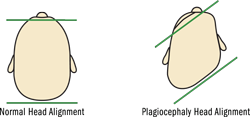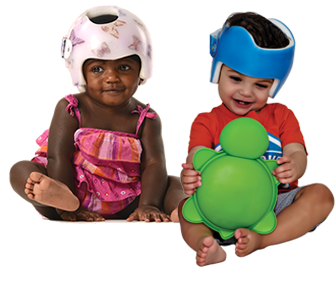Plagiocephaly is a condition where an infant’s head is asymmetrical, having an uneven or irregular shape. Clinically, it is referred to as deformational or positional plagiocephaly. This flattening can occur both prior to birth, during birth, and after birth.
Plagiocephaly

Plagiocephaly Symptoms
Fortunately, for parents, positional plagiocephaly is easy to recognize. The back of the head is usually flat. This can occur on one or both sides which results in an asymmetrical appearance. Another feature of plagiocephaly can be the appearance of a bulbous forehead. This may occur in more severe cases. If the neck is involved, where the muscles are shortened and it is difficult for the infant to lift their head on one side, this is referred to as torticollis. Torticollis is a very common condition that is associated with plagiocephaly. When it is present, symptoms of asymmetry may also be seen in the face, neck and/or jaw.
Most often, a doctor can make the diagnosis of positional plagiocephaly simply by examining the infant’s head. X-rays are usually not required, though an evaluation scan may be requested to determine the severity of the plagiocephaly. In some cases, a pediatrician my choose to consult with a specialist. This may be a pediatric cranial facial surgeon, neurosurgeon or plastic surgeon.

Plagiocephaly Causes
In 1994, the National Institute of Child Health and Human Development (NICHD) launched the “Back to Sleep” campaign which was aimed at reducing the risk of Sudden Infant Death Syndrome (SIDS). Because SIDS is the number one cause of death in infants younger than one year, experts agreed it was safer to put infants to sleep on their backs. While the incidence of SIDS has decreased by 50%, there has been a 9 fold increase in cases of positional plagiocephaly from 1999 – 2007.
Positional plagiocephaly is one of the most common forms of plagiocephaly. It is due to the baby spending most of their time on their backs in the same position. Due to the soft moldable nature of an infant’s skull, resting the head on a flat surface for extended periods without sufficient Tummy Time can lead to flattening. As an infant with a flat spot is continuously put in the same position, the flat spot increases. In some cases, this may lead to a forward shift of the ipsilateral ear and forehead causing facial asymmetry.
In addition to being put to sleep on the back, many infants spend time in the same position because of changes in technology and the invention of mobile baby car seat carriers. With a simple click, the baby is taken from stroller to car and vice-a-versa. Often, infants remain in the carriers placed on a table simply because it is convenient, and the baby is comfortable. The result is that the back of the baby’s head receives constant pressure and the baby is not using their neck muscles.
Some infants are actually more prone to plagiocephaly. Preemies or premature babies have softer skulls than full-term babies. Moreover, they often have medical complications and thus, are not picked up as often which leads to more time on the back.
Another group which shows a higher incidence of plagiocephaly are infants from multiple births. It has been suggested that plagiocephaly is more common with this group, as they present with more of the risk factors associated with plagiocephaly. These include: low birth weight, intrauterine constraint, intrauterine position, premature birth and congenital muscular torticollis.
Congenital muscular torticollis (CMS) occurs very often with infants with plagiocephaly. Torticollis refers to a tightening or shortening of the neck muscles and congenital refers to occurring at birth. An estimated 80 – 90% of infants with CMS also have plagiocephaly.
There appears to be a cause and effect relationship with CMS and plagiocephaly. Infants born with CMS have difficulty lifting their head on the affected side. Thus, they will keep their head in one position leading to plagiocephaly. Conversely, infants with plagiocephaly and a significant flat spot have a bigger challenge in turning their heads to the opposite side. They, therefore, do not use their neck muscles which become stiff.
Fortunately, plagiocephaly is quite easy to treat with helmet therapy.

Plagiocephaly Treatment
Non-synostotic positional plagiocephaly is rated on a scale of 1 – 5 by physicians. The severity of the plagiocephaly, determines the type of treatment. Milder forms of plagiocephaly may be treated with repositioning and Tummy Time exercises. Moderate to severe forms are usually treated with a combination of cranial remolding orthoses (CRO) with Tummy Time. In certain cases, physical therapy is also needed.
Non-synostotic plagiocephaly does not require surgery. It is only when a child has craniosynostosis, a premature fusion of a suture, that surgical intervention is required.
For complete details of cranial remolding helmet treatment, please visit our Treatment section.



